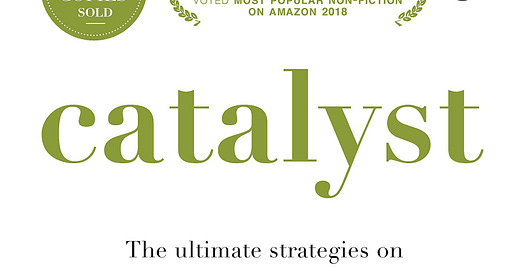Book review: catalyst by Chandramouli Venkatesan
pick it up and read. treasures on career growth and management, for everyone
This is the first book of Chandramouli that I read on being recommended by a good friend of mine. Being a little skeptical, I gave it a try. Gosh! I am glad that I did.
So, this book across as a great read to me. That’s because its explained in simple language and sans jargons.
Yes! It’s as though the author himself speaks to the reader—calm, clear and assertive—as we see Mouli in the videos.
Concepts conveyed are relatable and seem actionable in the corporate context. The test of validity may still depend on the individual and differ by the situations/environment encountered. Hence, the book acts as wonderful guide that can be referenced once in a while by the practitioner at various points in his/her career path.
And, this book is particularly handy for starters or with less than 3 years of corporate experience. This is not to rule out people way up in the curve. There are gems for everyone along the way.
In this post, I highlight the key take aways in Part I of the book and in a subsequent post cover the other parts of the book as well.
Come, lets take a glimpse!
Chapter 1 individual growth
-focus on individual growth(IG)—converting time into experience forms the basis of real IG
-IG is a function of skills, knowledge, decision making, judgement, influence, communication— basically pushing yourself beyond your limits
-time spent at work is not experience—the same has to be catalysed
-focus on deeds leading to career growth vs. focusing on just end result (promotion, team captain etc…)
-impact of life on work> impact of work on life
Chapter 2 real experience counts
-presence of a learning model catalyses activity into experience
-target, measure, review and reflect(TMRR) algorithm is the catalyst to convert time to experience
-effective use of TMRR model translates into solid basis for experience building
-anchor the habit of reflection: “what could have I done better?”
Chapter 3 maximising learning cycles
-major project or initiative in the company you work for indicates potential learning cycle; ask the management to be a part of such projects
-example of an artist and performance—combination of size of stage and the size of audience—high performance will result in tremendous impact
-broaden your engagement lens—contribute to the all round project development, dont restrict yourself to just the functional requirement
-increase the intensity of your engagement and prioritisation in terms of concentration, creativity, communication and discipline
-get on the thought leadership level—assess your ability to operate at a higher level than the one in your organisational position
Chapter 4 improving personal productivity
-concoction for success is combining experience with productivity; pivot one’s capability through diligent and disciplined time management
-higher productivity will help deal with the quantity/breadth of issues; complexity and ambiguous situations in particular
-Knowing when to delegate stuff to team members as you climb seniority levels is important
-use ‘circle of influence’ and ‘rocks first’ method to improve productivity
-focus on sphere of influence (something that you can directly impact) that will push you towards delivering high quality and high quantity of work
-spending time on circle of concern vs. circle of influence is a time killer and produces minimal results; it crushes the energy for the rest of the day
-calendared allocation of time at work is the ‘rocks’—if the rocks are allowed to be put in a jar then the sand flows through the rest of the time and finds a place for itself. This way attack the most important stuff at work that requires your time, energy and attention
-hence, productivity will not happen on its own. It has to be catalysed.
If you have read thus far, thanks for scrolling through. I hope the points stacked above offered some food for thought. And yea, do leave your thoughts in the comment section.
Catch you in Part II review.
Until then, Ciao!



